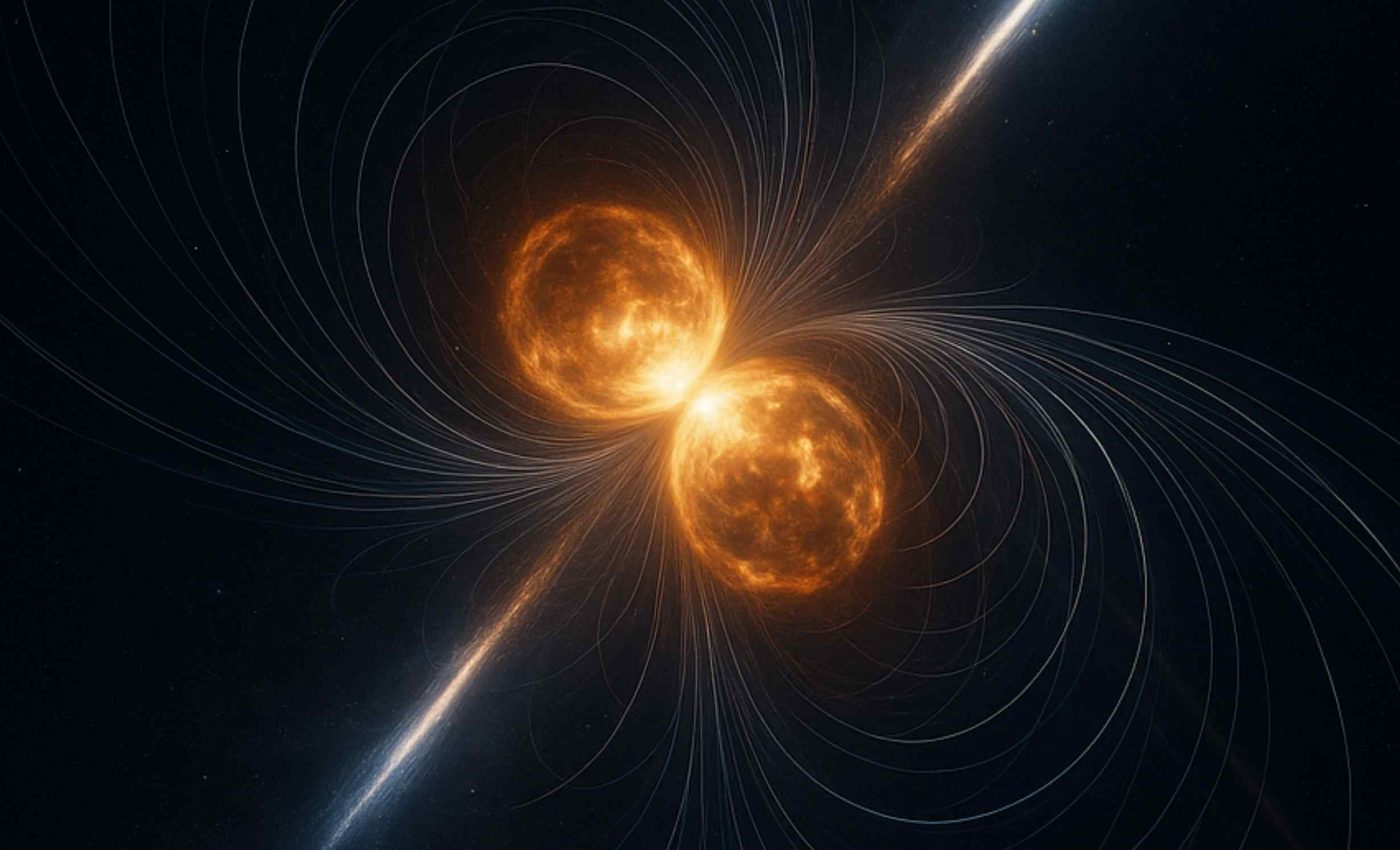
High-energy cosmic rays may form during the magnetic chaos of black hole birth
Cosmic rays hit Earth’s atmosphere all the time, but most are too weak to detect. A few, however, carry extreme energy: more than a million times what particle accelerators on Earth can produce.
A new study suggests that those monsters are born in the churning magnetic fields of pairs of neutron stars that are on the brink of collapse. The high-energy rays are thought to arise moments before a black hole flickers into existence.
Glennys Farrar, a theoretical physicist at New York University, argues that this brief window of magnetic bedlam can sling charged nuclei far beyond 100 exa‑electron volts (EeV), topping what the Large Hadron Collider can muster by a factor of a million.
High-energy cosmic rays and human machines
Farrar’s name carries weight in the hunt for Ultrahigh-Energy Cosmic Rays (UHECRs), a class of particles first recognized in the 1960s. They arrive so rarely that a detector the size of Delaware might record one a year.
The most recent UHECR detected by the telescope array in Utah was nicknamed “Amaterasu,” and it clocked in at 240 EeV, making it the third most energetic cosmic ray ever recorded. It made headlines for coming from a seemingly empty part of space.
Astrophysicists once blamed active galactic nuclei, gamma‑ray bursts, or the collapse of massive stars for such energies. Yet decades of sky maps reveal no tidy link between those explosions and the arrival directions of UHECRs.
Kotera and Olinto’s classic review noted that magnetic fields scramble most cosmic rays, hiding their tracks, but still could not explain why the very top end seems to follow a tight energy‑to‑charge relation. Farrar’s model now tackles that puzzle head‑on.
Merging stars, messy magnets
When two city‑size neutron stars spiral together, their crusts shatter and magnetic fields twist like pulled taffy. Supercomputer runs show those lines amplifying a thousand‑fold in under eight milliseconds, priming a natural particle accelerator.
Before the merged core collapses, the tangled field ejects blobs of plasma moving at near‑light speed.
Charged nuclei surfing that turbulence gain energy in proportion to their electric charge, matching the observed rigidity trend that has stumped earlier theories.
The same chaos also explains why only a few particles breach 200 EeV. Farrar points out that the heaviest r‑process nuclei – xenon, tellurium, and maybe even uranium – are rare in the debris, so only a handful reach truly extreme energies.
Those r‑process elements form when neutrons jam into seed nuclei during the merger, the same alchemy that minted much of the universe’s gold and iodine.
Gravitational‑wave event GW170817 provided smoking‑gun evidence for that elemental factory when telescopes caught a kilonova glow rich in lanthanides.
Clues from gravitational waves
If Farrar is right, the loudest cosmic rays should coincide in time and sky position with measurable gravitational waves. That offers an observational lifeline because LIGO‑Virgo‑KAGRA can time‑stamp mergers to within milliseconds.
The model further predicts a burst of neutrinos above 10 peta‑electron volts that would be created when the newborn cosmic rays smash ambient photons.
IceCube’s latest 12‑year search tightens the limits on such events but has not yet ruled the idea out.
Unlike photons or cosmic rays, neutrinos fly straight through magnetic fields, so catching a high‑energy neutrino alongside a merger would be a smoking gun.
IceCube‑Gen2, now in planning, is expected to boost sensitivity by an order of magnitude, making that coincidence test feasible within the next decade.
High-energy cosmic ray paper trail
Data from the Pierre Auger Observatory already hint that the highest‑energy particles are not simple protons but heavier nuclei.
That composition trend squares with Farrar’s call for rare r‑process atoms, although Auger’s statistics above 100 EeV remain thin.
Next‑generation ground arrays in Utah and Argentina aim to triple exposure and sharpen mass estimates through improved muon measurements.
If they find tellurium or xenon signatures in air‑shower profiles, the merger‑accelerator picture would gain serious traction.
Radio telescopes add another breadcrumb. When UHECRs skim the atmosphere they emit nanosecond radio flashes; mapping those flashes back to a recent gravitational‑wave event would tie the chain from merger to magnet to particle.
Theorists are not off the hook. Simulating magneto‑hydrodynamic turbulence at the needed resolution still pushes current supercomputers, leaving uncertainties in exactly how long the acceleration window stays open.
What happens next
Farrar’s framework turns several competing mysteries into one experiment: catch a merger, a neutrino, and a cosmic ray from the same patch of sky within days.
Such a trifecta would let researchers measure the particle’s charge, the merger’s energy budget, and the strength of the intervening magnetic fields.
Until that day, every extreme particle that pings a detector is another clue.
Some may still come from runaway black‑hole jets, but the new theory hands astronomers a clear recipe to test and perhaps this will allow the older suspects to be retired.
The study is published in Physical Review Letters.
—–
Like what you read? Subscribe to our newsletter for engaging articles, exclusive content, and the latest updates.
Check us out on EarthSnap, a free app brought to you by Eric Ralls and Earth.com.
—–













